Top News
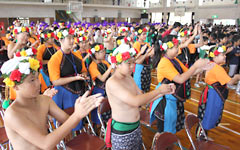
November 4, 2012 Ryukyu Shimpo
“Inabayo (Hello),” “Haisai,”
On November 2, about 40 members of the samba team of Taiping Elementary School, including pupils, teachers and representatives of the Puyuma people, from Taitung County, Taiwan, visited Shonan Elementary School, in Haebaru showcasing their traditional arts in a friendly exchange.
The children in the Taiwanese samba team were guests in the Shonan Elementary School event held as part of the traditional culture week to which parents and local people are invited. Fifth and sixth-grade pupils of Shonan Elementary School performed Ryukyu dance and sanshin, karate and eisa. Pupils of Taiping Elementary School, dressed in their brightly colored ethnic costume, performed a powerful display of samba percussion and acted out a monkey festival, an example of the traditional arts of the Puyuma people in which young men test their courage. The Taiwanese children enjoyed dancing the Haebaru Ondo in the finale.
Elementary schools for the indigenous people of Taiwan have established a unique style of percussion played while dressed in the national costume of each tribe, and have incorporated the samba into its lessons in an attempt to help pass on traditional performing arts. Midori Onaga, who is from Naha, played a key in inviting the Taiwanese children to Okinawa.
Shonan Elementary School sixth-grade pupil Rin Akamine, who performed eisa, said, “Their colorful costumes and leggings are similar to those used in our traditional performing arts in Okinawa.” Chou Yu Fan, a sixth-grade pupil of Taiping Elementary School going overseas for the first time, said, “I am very happy to be so warmly welcomed.” Wu Xiu Jin, the president of the elementary school and Lin Qing Mei, an elder of the Puyuma people said that they were very impressed by Okinawan traditional performing arts.
On November 4, the samba team paraded down Heiwa-Dori in Naha and performed at Sakurazaka Theater.
(English translation by T&CT, Mark Ealey)
Go to Japanese
November 6, 2012 Ryukyu Shimpo
On November 5, the executive committee of the protest rally against the Osprey deployment met to decide the schedule for the heads of the 41 municipalities in Okinawa to visit Prime Minister Yoshihiko Noda in order to protest in person against the deployment of the MV-22 Osprey aircraft to the prefecture. They hope to meet Noda on December 17. From 3:00pm on December 16, the committee will hold the Tokyo rally at the Hibiya Open Air Concert Hall, then from 4:00pm, they will hold a protest march around Ginza.
The Mayors Association, Town and Village Association and Association of Heads of the Municipal Assembly, Association of Heads of Town and Village and Okinawa Prefectural Assembly will put together a group to meet Noda. Forty eight of the members of the Prefectural Assembly plan to be in the group and as many as 150 people could possibly participate. The committee currently expects about 130 people to join the group. If Prime Minister Noda refuses to allow all of the participants to attend, those who are rejected will hold a sit-in protest in front of the Prime Minister’s Official Residence. The committee will hold press conferences for Japanese and foreign reporters. It also calls for members of the Okinawa Associations of Tokyo, Saitama and Chiba, Kanagawa, to come to participate in the Tokyo rally and the protest march, aiming to attract 5000 participants.
At this stage, the committee is unable to confirm whether or not the Prime Minister will agree to meet them, so it is possible that the schedule could change. The committee will report on developments regarding the schedule at its meeting due to be held on November 13.
At a meeting on November 5, the committee explained how the municipalities will hold rallies, some co-hosted, to protest against the deployment of the Osprey. Twenty municipalities have already held 17 rallies. Two cities and two towns including Uruma and Kin will hold protest rallies before the end of this month.
(English translation by T&CT, Mark Ealey)
Go to Japanese

November 5, 2012 Ryukyu Shimpo
On November 4, a photograph entitled No Osprey, which captures a scene of a protest against the deployment of the tilt-rotor aircraft, won the highest award in a high school photography contest. Kanna Higa, a sophomore of Urasoe Technical High School, took the photograph in front of the Nodake Gate of Futenma Air Station on September 30. The photo contest was part of the Okinawa Prefectural Comprehensive High School Cultural Festival held to commemorate the 40th anniversary of Okinawa’s reversion from U.S. rule to Japanese sovereignty, which was the theme of the contest. Higa took the photograph as she heard people yelling angrily amid clashes between citizens and police. She said, “I am grateful to the people who allowed me take pictures of them.”

Kanna Higa
When Higa read the newspaper on the morning on September 30, she realized that the gates of Futenma Air Station had been blocked. Wondering what was happening, Higa picked up her camera, and went to the Samashita Gate, which is located close to her house. She spoke to one of the people on the sit-in protest, and asked for permission to take pictures of the people. Realizing Higa was a high school student, the man agreed straightaway.
Higa got to three of the gates to the base, Samashita, Ooyama and Nodake, but almost had second thoughts at the tense scenes she witnessed in front of the Oyama and Nodake gates. The protesters shouted, “The police are supposed to protect citizens! Why are you protecting the United States?” Higa pressed the shutter button for all she was worth as the police officers tried to remove the people on the sit-in protest and the cars parked in front of the gate.
Despite the protests, the Osprey were deployed in Okinawa the next day. Higa is distressed to think of the people who continue to participate in the sit-in protest. She said, “I don’t know what is going to happen in future. I want to keep taking photographs, and consider the issues facing us.”
(English translation by T&CT, Mark Ealey)
Go to Japanese

October 31, 2012, Ryukyu Shimpo
On October 30, at Tomigusuku High School, the women’s weightlifting silver medalist Olympian, Hiromi Miyake and her coach as well as her father, Yoshiyuki were invited to give a talk on “The Path to the Silver Medal—Reaching for your Goal.” It was Hiromi Miyake’s third time to test herself at the Olympics. She encouraged students at the high school, saying, “I continued to keep on going even when I was not doing so well. The key for me was to face up to challenges and never give up.” Her father, Yoshiyuki, also received a bronze medal in the featherweight division at the Mexico Olympics in 1968. He remembered when she started weightlifting and said, “I didn’t suggest that she take up weightlifting. I just tried to support her so that her dream would come true.”
At the talk, when she was asked what sort of student she was when she was at high school, she replied, “I was totally focused on weightlifting. Going to the Olympics was my goal, so I consciously pushed myself to do different training to the others.” One of the students, Tatsumi Ichi put Miyake’s silver medal around his neck, and said, “It was heavier than I thought.”
(English translation by T&CT, Kyoko Tadaoka and Mark Ealey)
Go to Japanese

November 06, 2012 Ryukyu Shimpo
On November 5, learning from the Great East Japan Earthquake, the Okinawa Prefectural Government and all municipalities conducted evacuation drills in many parts of Okinawa for the first time this year, on the basis that a huge earthquake and tsunami had occurred.
About 120000 people from 800 organizations participated in these drills. The emergency alert system that sent e-mails simultaneously to mobile phones across the prefecture was tested. Residents practiced going to higher floors in taller buildings and to higher ground through U.S. military bases in order to practice fleeing from a tsunami.
The Chatan Municipal Office has designated 33 facilities as the tsunami evacuation buildings on the west coast of the town in the case of possible disasters.
An evacuation drill for children was also held in Aiiku Nursery School. One hundred seventy children from 11 classes, including children aged to five years old, evacuated to the roof of the eight-story building next to the nursery school with their parents and staff members.
Chatan Mayor Masaharu Noguni and many municipal office members also took part in the drill.
(English translation by T&CT, Mark Ealey)
Go to Japanese
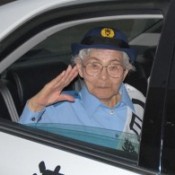
October 24, 2012 Ryukyu Shimpo
On October 11, the opening ceremony of the Japan Community Safety Campaign in Motobu was held at Motobu Police Station. Haruko Izena, who is 95 years old and famous in her region as an energetic grandmother, worked as a police chief for one day. She saluted and paraded from the police station to Motobu Bridge by police car.
Izena who lives in Nakasone in Nakijin, ran a fish shop until she was 88 years old, and she has five children, six grandchildren and nine great-grandchildren. Since retiring, she has been enjoying karaoke and sings traditional Okinawan songs and folk songs. “This was my first time to be selected as a police chief but I’m happy that many people came along. I would like to help safeguard the community together with residents,” said Izena.
About 100 members of the Motobu Crime Prevention Association participated in the ceremony. Masayuki Yamane, the chief of the Motobu Police Station, stated that they will particularly focus upon the prevention of car break-ins. He also said that they intend to work together to safeguard the community in Motobu Town and in the villages of Iheya, Nakijin, Izena and Ie so the 32000 residents can live in peace.
(English translation by T&CT, Lima Tokumori and Mark Ealey)
Go to Japanese
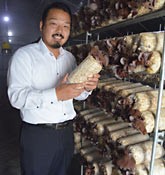
October 31, 2012 Maki Nagamine of Ryukyu Shimpo
TAKI Farm in Nishihara produces wood ear grown in Okinawa, which has an appropriate subtropical climate, and markets them as “Ryukyu Wood Ear.” By March 2013, the company plans to have four greenhouses with twice the capacity the present condition and also will build a mushroom bed plant on its property.
TAKI Farm aims to produce 100 tons of wood ear in the 2013 fiscal year, which is ten times the current level, aiming at one million yen in sales per year. In anticipation of this, Toyoharu Takiishi, the president of the company said, “I want to make Okinawa Japan’s best production site for the wood ear fungus.”Production volume of wood ear in Okinawa is currently less than 10 tons a year and the number of farm producers is only small. The company already produces cloud ear fungus (Auricularia polytricha) for which mushroom beds are obtained from Kumamoto Prefecture, where Takiishi is from. While wood ear distributed in Japan are mostly grown overseas, the company wants to persevere with domestically product and to brand them as such.
The fungus grows in one month after mushroom beds are laid. After picking, the fungus grows again. One mushroom bed produces a total of about 500 grams of wood ear. The beds are changed three times a year.
Takiishi said that the Okinawan climate with its high-temperatures and humidity is suitable for wood ear production. Characteristically, the Ryukyu wood ear is unique in terms of its thick and crunchy texture. They are nutrient-rich with fiber, iron, and calcium. The company has distributed recipe books at supermarkets and has introduced stir-fry, salad, and hot-pot recipes.
Takiishi moved to Okinawa in 2005. He currently manages a company that does electrical and air conditioning work. Recommended by friends, he started growing wood ear two years ago aiming to contribute to increasing employment levels.
Wood ear is sold at 198 yen including tax for one 80 gram package at Ion Haebaru Store. The company hopes to sell them at all of the Ion Group stores in Okinawa, and also intends to establish a production cooperative association, so they will attract approximately 20 farmers in two years. TAKI Farm will distribute mushroom beds produced in their plant, which will be built next year, and expect to produce 36 beds, and 180 tons for all of the association. Takiiishi said, “We will gather farmers as we explore business opportunities both inside and outside of Okinawa. I would like to increase employment levels and continue this business for a long time yet.”
(English translation by T&CT, Megumi Chibana and Mark Ealey)
Go to Japanese
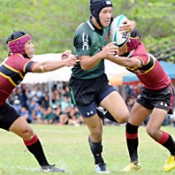
November 2, 2012 Risa Arakaki of Ryukyu Shimpo
On November 1, at the Okinawa Prefectural Sports Park rugby field, the final of the Okinawa Prefecture tournament was held for the 92nd Japan National High School Rugby Championships. Koza beat Nago 38-22, and won the right to participate in the National Tournament at Hanazono in Osaka for the second consecutive year, its 12 time to represent Okinawa.
In the first minute, influential Koza flyhalf Kenichiro Kuwae scored the opening try, but a series of errors stopped his team from taking total control, so Koza went into the halftime break leading 17-10, after conceding two tries to Nago.
However, in the second half, Koza shook off Nago, scoring three tries in quick succession by moving the ball wide at every opportunity. The opening ceremony and first games of the National High School Rugby Championship will be held at Kintetsu Hanazono Rugby Stadium on December 27.
Koza HS defeated Nago HS 38-22 (17-10, 21-12)
(Koza will compete at Hanazono for the second year in a row and represents Okinawa for the 12th time.)
In second half, employing a high-tempo game, Kuwae spearheaded his team’s determined attacks on the Nago goal-line.
Koza came into its own in the second half, skillfully employing decoy runners to pull in the opposition’s defense and also using kicks well. Scored three quick tries, in the end, Koza defeated Nago through its high-tempo, “wide-wide” approach making use of the full width of the field.
In the 57th minute of the second half, Kuwae scored a second try as Koza launched an onslaught on their opposition’s goal-line. Winning their own set-piece comfortably, the Koza players moved the ball to the left and to the right with Kuwae as the key attacking link. Every time the opponent’s defense stopped them Koza continued to second and third phase attacks, happy to move the ball out from their own half until they eventually got it over the Nago line.
By 24th minute of the second half, Koza had scored another three tries to lead 38-10.
Director of Rugby at Koza High School Yutaka Toma said that they played “some exceptional rugby.” Koza succeeded in all of their six conversions and were superior to Nago in the accuracy of their kicking in general. However, in the last minutes of the game, Koza was put on the back foot in rucks and mauls by Nago, and conceded two tries. Toma said, “The Nago players understood the importance of scoring in the closing stages, and in that mental aspect of the game, they beat us hands down.” He vowed to work on his team’s mental toughness.
“We let our standards slip right at the end,” said captain, Hikaru Uesato, when reflecting on the defensive lapses in the final minutes. He went on to say, “We put in a lot of work in running during spring and summer, so we were able to play this kind of expansive game.”
Almost all of the core members of this team are the same as last year, so it is effectively the second attempt for these boys to make an impression at the Hanazono tournament. Ahead of playing on the big stage, Kuwae said, “I am bigger physically now so I can carry the ball forward more effectively. We intend to play our style of running rugby and aim to get into the quarter-finals.”
(English translation by T&CT, Mark Ealey)
Go to Japanese
Weight loss with Garcinia Cambogia, user and expensive not gentle of the weight loss, compared to other methods, efficient and effective way simple. Cambogia Garcinia extract as follows can be summarized how to help in weight loss. It is by controlling the desire for food, it suppresses appetite in humans., user and expensive not gentle of the weight loss, compared to other methods, efficient and effective way simple. Cambogia Garcinia extract as follows can be summarized how to help in weight loss. It is by controlling the desire for food, it suppresses appetite in humans.
November 2, 2012 Ryukyu Shimpo
On November 2, the final of the 131st High School Baseball Championship of the Kyushu region was held at the Nagasaki Prefectural Baseball Ballpark. These games decide the schools that will compete in the National Championship in next spring. Okinawa Shogaku High School, representing Okinawa, beat Seiseiko High School of Kumamoto Prefecture 5-0, winning the championship for the first time. The last school representing Okinawa to win this championship was Kadena High School in 2009, and the win makes it highly probable that Okinawa Shogaku will qualify to participate in next spring’s National Championship.
Okinawa Shogaku started the championship from the second round, and they got off to a good start by defeating Miyazaki Prefecture representative Nisho Gakuen High School, 4-2. In the quarter-final match Okinawa Shogaku came up against Kumamoto Technical High School. In the early innings of that game, the pitcher of Kumamoto Technical overpowered the Okinawa Shogaku batters, but while Kumamoto Technical did mount a comeback, Okinawa Shogaku eventually got on top of the opposition pitcher in the latter innings, and won a close game 3-2 in the extra-innings.
In the semi-final, Okinawa Shogaku met Soseikan High School from Nagasaki Prefecture. Okinawa Shogaku’s attacking play was strong, with it scoring the first four runs. After adding another four points the mercy-rule ended the game in the seventh innings, with Okinawa Shogaku winning 8-1.
(English translation by T&CT, Mark Ealey)
Go to Japanese
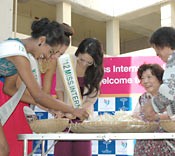
October 29, 2012 Ryukyu Shimpo
On October 25, the 52nd Miss International, Ikumi Yoshimatsu, who is from Japan, and the top five finalists visited the Nago Municipal Market where they interacted with local people.
Divided into a Miss Team and the Citizen Team, they competed to remove as many roots of bean sprouts as they can in three minutes. Three pageant contestants, including Yoshimatsu, challenged market’s employees Chiyo Nagano and Hideko Gushiken to a race. Both teams removed the same amount of fibers, but the Citizen Team, who have doing this kind of work for 50 years, came out ahead because they didn’t leave any fibers on the table, while the Miss Team scattered many bean sprouts around.
With “Yambaru beauty” as the theme, the young women took part in another event in the northern part of the main island of Okinawa. They enjoyed a breakfast made up of food good for health and beauty. The vegetables for this were provided by the Yambaru Farmers Project, which aims to promote the local community through agriculture.
Yoshimatsu said, “I’m grateful for the kindness of the Nago people. This was my first time to try removing bean sprout fibers, and I really enjoyed myself. I would also like to thank everyone for the healthy meal.”
(English translation by T&CT, Lima Tokumori and Mark Ealey)
Go to Japanese
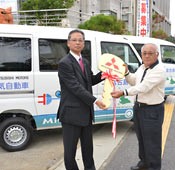
October 31, 2012 Ryukyu Shimpo
On October 30, the Miyako-jima Municipal Office and Mitsubishi Motors signed an agreement on the promotion of electric vehicles (EV). They will strive to spread the use of EV, using initiatives such as installing fast chargers for these vehicles in the city’s main tourist attractions. It is the first time that an automobile manufacturer has entered into such an agreement with a local government to promote the use of EV in the prefecture. In order to reduce carbon dioxide emissions, in 2008 Miyako-jima Municipal Office declared the island to be “Eco Island Miyako-jima,” and set the goal of EV accounting for about 40% of the vehicles on the island by 2030. Under this agreement, they will cooperate in measures to spread the use of these vehicles.
The municipal office will set up quick chargers at four places in the city for tourists before the end of the 2012 fiscal year.
Miyako-jima City Mayor Toshihiko Shimoji commented, “Electric vehicles have become more popular in Miyako, but still not to the extent that we want to see. We want people here to become much more familiar with EV, in a way that sees them more connected with our citizens. Working with Mitsubishi Motors, we would like Japanese and foreign people to understand what is good about these cars.
Yoshikazu Nakamura, the director of domestic sales for the company said, “I think that electric vehicles are a perfect fit for a small, remote island where drivers travel short-distances and gasoline is expensive. I also want people to make effective use of portable batteries at times of a disaster such as typhoons.” The company is allowing the prefectural office to use two electric minicabs at no charge.
(English translation by T&CT, Mark Ealey)
Go to Japanese










 Webcam(Kokusai Street)
Webcam(Kokusai Street)


